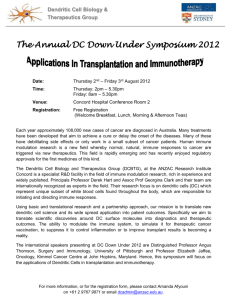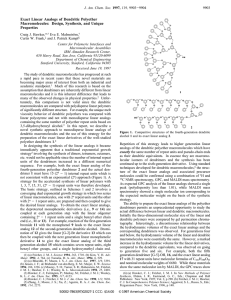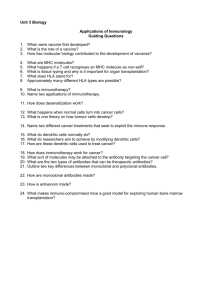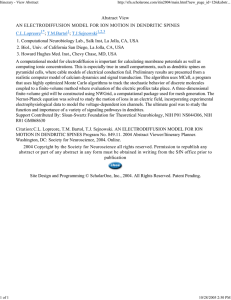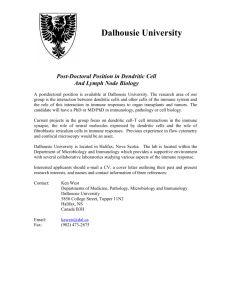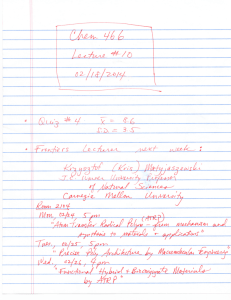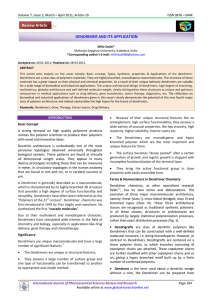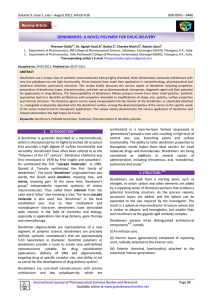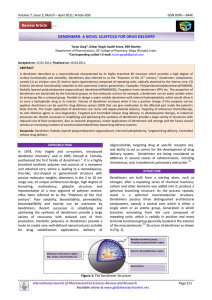Dendritic Nanomaterials for Environmental Remediation Mamadou Diallo
advertisement
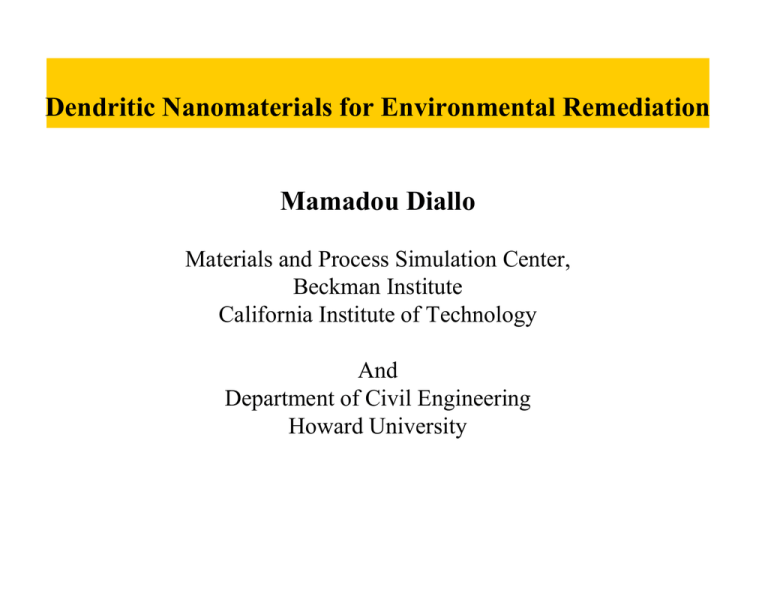
Dendritic Nanomaterials for Environmental Remediation Mamadou Diallo Materials and Process Simulation Center, Beckman Institute California Institute of Technology And Department of Civil Engineering Howard University Presentation Outline Synthesis and Characterization of Dendritic Nanomaterials Unique Properties Dendritic Nanomaterials (1) Nanoscale container and scaffolding properties (2) Amplification and functionalization of surface groups (3) Building blocks for mesoscale assemblies with well defined nanosized domains (4) Dendritic effect Applications to Environmental Remediation (Focus on Water Treatment and Soil Remediation) (1) High capacity and recyclable ligands for cations and anions (2) Recyclable unimolecular micelles for organic solutes (3) Redox and catalytically active dendritic nanoparticles (4) Bioactive dendritic nanoparticles Outlook on Dendritic Nanomaterials and Environmental Remediation (1) Fate, transport and toxicity of dendrimers nanomaterials (2) Development of low cost dendritic nanomaterials Acknowledgments The Dendritic Macromolecular Architecture (Tomalia, D. A. Aldrichimica Acta. 2004, Vol 37, No 2, p. 39) • • Dendritic Architecture: predicated upon the covalent linkage of molecular connectors and branching points to a core with multiple branching sites High level of Synthetic Control: makes possible the synthesis of nearly monodisperse nanoscale ligands with well defined molecular composition, size and shape Divergent Synthesis of Poly(amidoamine) Dendrimers with Ethylene Diamine Core (EDA) and NH2 Terminal Groups Convergent Synthesis of Poly(Benzyl Ether) Dendrimers (Hawker, C. and Frechet, J. M. J., JACS, 112, 7639, 1990) Chemical Characterization of Dendritic Macromolecules (Tomalia, D. A. Aldrichimica Acta. 2004, Vol 37, No 2, p. 39) • • • • • • 1H and 13C NMR Spectroscopy HPLC Size Exclusion Chromatography (SEC) Capillary Electrophoresis (CE) Polyacrylamide Gel Electrophoresis (PAGE) MALDI and ESI Mass Spectrometry Characterization of the 3-D Structures of G5-NH2 PAMAM Dendrimer by Molecular Dynamics Simulations in Water (Maiti et al. Macromolecules, 2005, 38, 979-991) (Lin et al. J. Phys. B., 2005, 109, 8663-8672 ) Unique Properties of Dendritic Macromolecules (Tomalia, D. A. Aldrichimica Acta. 2004, Vol 37, No 2, p. 39) Dendritic Nanomaterials as High Capacity and Recyclable Ligands for Cations (Diallo et al. Langmuir. 2004, 20 (7): 2640-2651) 160 G4-NH2 pH 7 replicate 1 G4-NH2 pH 7 replicate 2 G4-NH2 pH 7 replicate 3 G4-NH2 pH 9 G4-NH2 pH 5 140 120 100 EOBmax2=74.0 80 60 40 20 EOBmax1=12.0 0 0 20 40 60 80 100 120 140 160 Metal-Ion Dendrimer Loading (mole/mole) Environmental Applications of Dendritic Nanoscale Chelating Agents Recovery of Metal Ions [e.g. Cu(II)] from Aqueous Solutions by Dendrimer Enhanced Ultrafiltration Removal of Cu(II) from Contaminated Soil Using PAMAM Dendrimers (Xu, Y. (Diallo et al. 2005, Environ. Sci. Technol. 39, 1366-1377 and Diallo, M. S. US Patent Pending) and Zhao, D. 2005, Environ. Sci. Technol. 39 2369-2375) Dendritic Nanomaterials as High Capacity and Recyclable Ligands for Anions in Aqueous Solutions Anions have a variety of shapes (Gloe et al. Chem. Eng. Technol. 2003, 26,1107-1117) Birnbaum et al. Sep. Sci. Technol. 2003, 38, 389-404). Dendritic Macromolecules as Unimolecular Micelles for Organic Solutes (Striba et al. 2002, Angwate. Chemie. Int. Ed., 41 (8), pp 1329-1324) MD Simulations of the Meijer Dendrimer Box Miklis et al. 1997, JACS, 131, 7458 Catalytic Dendritic Macromolecules (Astruc D. and Chardac, F. Chem. Rev. 2001, 101, 2991-3023) Dendrimer-Encapsulated Zero Valent Metal Clusters (Scott et al. J. Phys. Chem. B. 2005, 109, 692-704) Bioactive Dendritic Macromolecules (Chen et al. 2000, Biomacromolecules, 1 (3): 473-480) Outlook: Fate, Transport and Toxicity of Dendritic Nanomaterials • Numerous dendrimer toxicity and biodistribution studies have carried out during the last 5 years – The effects of dendrimer core and terminal group chemistry, size, shape, hydrophobicity on dendrimer interactions with cell membranes and toxicity are becoming known and understood. • Only a limited number of studies have been published on the fate and tranport of dendrimers in the environment – Sorption of dendrimers onto mineral surfaces The Price of Nanotechnology (Slide Provided by Dendritic Nanotechnologies, INC) The retail price of the major classes of nanosized chemistries such as buckyballs, single wall nanotubes, dendrimers, and other nanoparticles are very expensive. Less expensive materials typically are impure, exhibit poor size control, and limited size range. Retail Price (per gram) Nanotechnology Low High (Less Pure) (Purified Product) Buckyballs $ 30.00 $ Single Wall Carbon Nanotubes $ 50.00 $ 2,000.00 Multi Wall Carbon Nanotubes $ 100.00 $ 500.00 PAMAM G0 Amino Dendrimers $ 82.00 $ 219.00 PAMAM G6 Amino Dendrimers $ 600.00 $ 3,000.00 50 nm Silica Bead $ 100.00 $ 100.00 50 nm Latex Bead $ 230.00 $ 230.00 Priostar™ Dendrimers $ 0.50 $ 5.00 Buckyball pricing from BuckyUSA, SW & MWCNT pricing from BuckyUSA, CNI, and Carbon Solutions Dendrimers pricing from Dendritech & DNT Silica and Latex Beads from Polysciences 120.00 Cost Profile: STARBURST® vs. Priostar™ Dendrimers Cost per gram $500 $400 Starburst® PAMAM $300 Priostar™ $200 $100 $0 0 1 2 3 Generation 4 5 6 Acknowledgments • Collaborators: Prof. William A. Goddard (Caltech), Prof. James H. Johnson, Jr. (Howard University), Prof. Jean Frechet (University of California, Berkeley), Dr. Donald Tomalia (Dendritic Nanotechnologies, INC) and Mr. Donald Phipps (Orange County Water Distric) • National Science Foundation (Funding) • Environmental Protection Agency (STAR Grant Funding) • Department of Energy (Funding) • National Water Research Institute (Funding) • NSF Sponsored Cornell Nanobiotechnolgy Center (Funding) • US Army High Performance Computing Ressearc Center (Funding)

